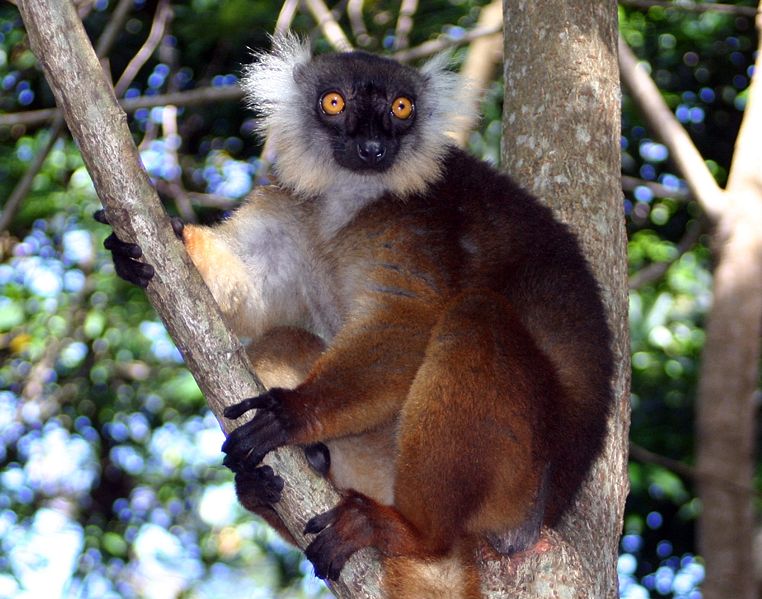- Black Lemur
Taxobox
name = Black LemurMSW3 Groves|pages=115|id=12100041]

image_caption = female
status = VU
status_ref = IUCN2006|assessors=Baillie|year=1996|id=8201|title=Eulemur macaco|downloaded=11 May 2006]
trend = down
status_system = iucn3.1
regnum =Animal ia
phylum =Chordata
classis =Mammal ia
ordo =Primate s
familia =Lemuridae
genus = "Eulemur "
species = "E. macaco"
binomial = "Eulemur macaco"
binomial_authority = (Linnaeus, 1766)The Black Lemur ("Eulemur macaco") is a species of
lemur from the familyLemuridae . Like all lemurs, it isendemic toMadagascar .ubspecies
There are two subspecies of Black Lemur:
* "Eulemur macaco macaco"
*Blue-eyed Black Lemur , "Eulemur macaco flavifrons"Consistent with its common name, the
Blue-eyed Black Lemur "E. m. flavifrons" has blue eyes, the only primate other than humans which has blue eyes. The nominate subspecies "E. m. macaco" has brown or orange eyes, and ear tufts.cite book|title=The Pictorial Guide to the Living Primates|author=Noel Rowe|page=41-42|year=1996|isbn=0-9648825-0-7] cite book|title=Mammals of Madagascar|author=Nick Garbutt|page=166-170|year=2007|isbn=978-0-300-12550-4]Both subspecies live in northwest Madagascar. "E. m. macaco" occurs in moist forests in the
Sambirano region of Madagascar and on nearby islands. "E. m. flavifrons" is restricted to theSahamalaza Pennisula and adjacent forests. There are reports of the two subspecies hybridizing where their ranges overlap inManongarivo Special Reserve .cite book|title=Lemurs of Madagascar|edition=Second Edition|author=Russell Mittermeier et al|page=288-293|year=2006|isbn=1-881173-88-7]Physical description
The Black Lemur is between 90 and 110 centimetes in length, of which 51-65 centimeters are tail. Weight typically ranges between 1.8 and 2.0 kilograms.
The Black Lemur displays
sexual dimorphism in coloration. Males have black or dark chocolate fur, while females' fur is of a lighter brown color, generally medium brown, chestnut brown or even orange-brown. Males of "E. m. macaco" have large black ear tufts, while females of "E. m. macaco" have large white ear tufts.The only other "Eulemur" species that occur within the range of the Black Lemur are the
Common Brown Lemur , "E. fulvus", which overlaps with "E. m. macacao" at the extreme southern and eastern edge of its range, anr theRed-bellied Lemur , "E. rubriventer", on theTsaratanana Massif . "E. fulvus" and "E. rubriventer" have different coloration and do not show the extreme sexual dimorphism of "E. m. macaco", making confusion between the Black Lemur and the species unlikely.Diet
The Black Lemur primarily eats fruitcite book|title=Primate Ecology and Social Structure Volume 1: Lorises, Lemurs and Tarsiers|author=Robert W. Sussman|page=186-187|year=1999|isbn=0-536-02256-9] , which makes up an estimated 78% of is diet. The ripeness of this fruit is vital to the lemur's diet.cite book|title=New Directions in Lemur Studies|last=Rakotosamimanana|first=Berthe|coauthors=Hanta Rasamimanana|publisher=Springer|year=1999|isbn=0306461870] Other foods eaten include flowers, leaves, fungi, some invertebrates and, especially during the dry season, nectar.
Behavior
The Black Lemur lives in both primary and
secondary forest . It is active both during the day and at night. It forages in both the upper and middle canopy, especially at night, and during the day it also forages in the understory. In degraded habitats, it also forages on the ground and may even eat soil.The Black Lemur lives in groups of 2 to 15 members, including approximately equal numbers of males and females. Average group size is about 10 members,cite book|title=Primates in Perspective | chapter = Lemuriformes | author = Lisa Gould and Michelle Sauther | editor = Christina J. Campbell, Agustin Fuentes, Katherine C. MacKinnon, Melissa Panger and Simon K. Bearder|year=2007|page=53|isbn=978-0-19-517133-4] although the average may be smaller for "E. m. flavifrons". Females are dominant over males, although intragroup fighting is rare.
Groups have home ranges of about 3.5 to 7
hectare s. Ranges overlap considerably, and population density can reach 200 individuals per squarekilometer .Reproduction
Mating usually takes place in April and May. During mating season, antagonism between males increases, and males sometimes roam between groups. After a
gestation of about 125 days, a single infant is usually born between late August and early October. Females typically give birth for the first time at 2 years of age.References
External links
*ARKive - [http://www.arkive.org/species/GES/mammals/Eulemur_macaco/ images and movies of the black lemur "(Eulemur macaco)"]
Wikimedia Foundation. 2010.
